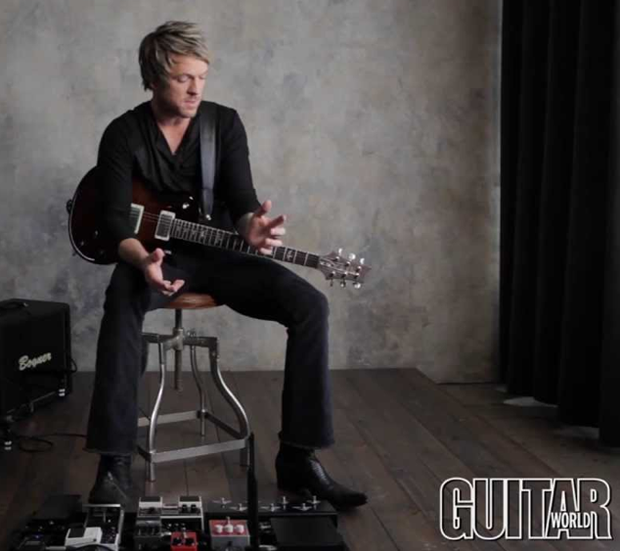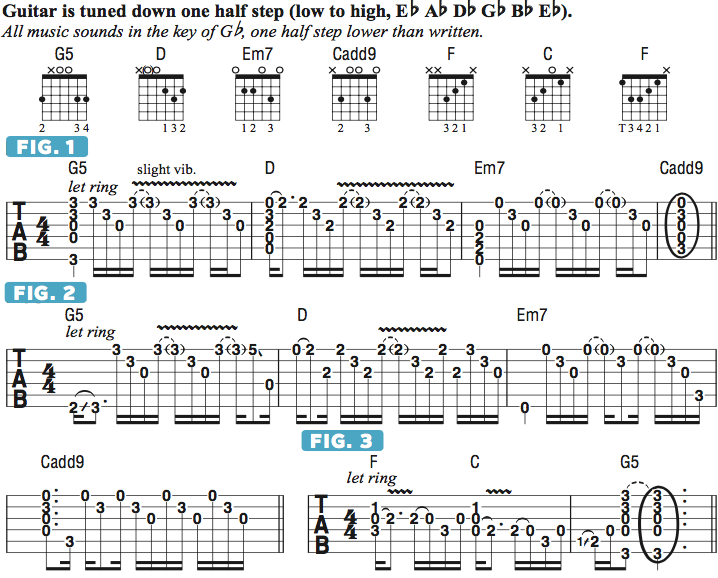How to Turn a Stock Chord Progression Into a Unique Guitar Part
How to sculpt a stock chord progression into a melodically interesting rhythm guitar part.

Last month I described how I harnessed my voice’s musical intuition as a creative guide when crafting a lead guitar solo in the studio.
This month I’d like to talk about another useful, creative approach, in this case one that can help shape and sculpt a stock chord progression into a melodically interesting rhythm guitar part that can serve as the foundation for a song.
One good way to stimulate songwriting ideas is to take either an acoustic guitar or a clean electric with a glassy tone and perhaps a little reverb and delay (à la Slash’s tone on the intro to Guns N’ Roses’ “Paradise City”) and just start playing around with a few chords that seem to go together naturally.
But instead of simply strumming them, you experiment with various ways of picking out their notes individually, which is a very effective compositional technique known as arpeggiation.
Figure 1 is a four-bar phrase I came up with on the spot for this month’s column, using the open chords G, D, Em and C as a starting point. My first thought was to apply a rolling picking pattern to the G chord at a moderately slow tempo, allowing the notes to ring together and selectively picking certain strings and avoiding others, resulting in an open-sounding G5 voicing. I then took that same arpeggiation pattern and applied it to the chords D and Em (see bars 2 and 3), which started to form a cohesive musical statement. Note the use of the hammer-on within the D chord, an idea that came to me by humming the top note of each chord and using those notes as guide tones, which led my fingers to that James Taylor–style move.
From Em, I then went to C, and as I cycled through the four-chord progression, I tried softly humming the next lower note in the voicing of the G5 chord, D, which is a common tone to both the G5 and D chords, and thought it would sound pleasing to keep that note going as a connective thread through all four chords, which led me to substitute Em7 and Cadd9 for Em and C. Including the open D string in the Cadd9 voicing gave it a slightly dissonant but sublime quality, which then inspired me to further “dress up” the progression melodically, resulting in Figure 2, which includes decorative single-note embellishments on the two outer strings. Suddenly, I had an intro for a song!
As these two examples illustrate, sometimes it’s good to not be so structured with your chord changes or voicings. Taking that concept a step further, another nice move I like to do in G is to break the “rules of the key” and go to the flat-seven chord, F, and utilize the open G string for hammer-ons and pull-offs, as Figure 3 demonstrates. These kinds of chordal embellishments and detours twist the ear in a playful way and are often all it takes to make a guitar part interesting and memorable.
All the latest guitar news, interviews, lessons, reviews, deals and more, direct to your inbox!
Figure 4 puts all these concepts together in a full-blown intro/verse-type part, with additional rhythmic-melodic embellishments demonstrated, such as sliding double-stops (bar 5), descending pull-offs across a voicing (bar 7) and the use of the left-hand thumb to fret the sixth-string root note of the F chord in bar 8, which faciliates hammer-on and pull-off activity on the G string within that chord shape.


